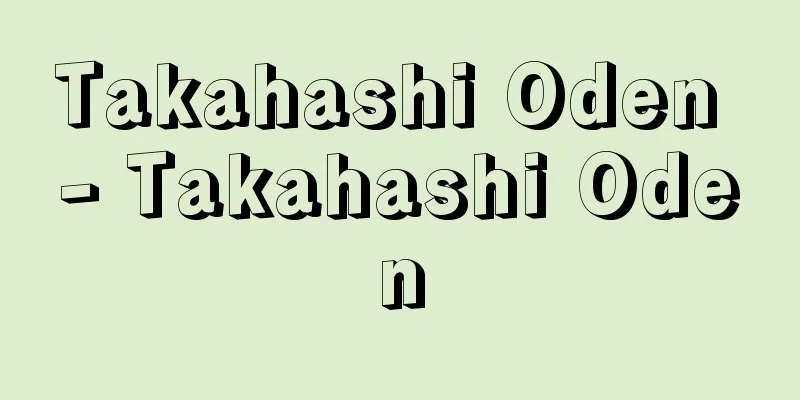Book

|
A plastic art that is expressed by writing Chinese characters and kana characters using a brush and ink. Calligraphy is a unique art that developed in China and Japan, and is closely related to the plastic elements of Chinese characters. In China, it has long been counted as one of the six arts (ritual, music, archery, imperial decree, calligraphy, and mathematics), and was a required liberal arts subject for government officials and intellectuals. Beauty in the brush, composition, ink color, and layout, as well as the author's style expressed in the work, are valued, and it was called the way of entering wood (jubokudo) and the way of writing (hitsudo) after the story of the calligrapher Wang Xizhi of the Eastern Jin Dynasty, whose brushwork was so good that ink penetrated three-fifths of wood. Calligraphy is not only a means of writing characters, but is also an object of appreciation as the artist's artistic creation. Therefore, printed characters and everyday practical documents are not called calligraphy. However, historical practical writing such as letters and copying sutras that are artistically excellent are appreciated as calligraphy. Typefaces, styles, and techniques vary depending on the era and school, but in recent years, while there have been efforts to explore and elucidate the classics, there have also been attempts to pioneer new fields that stray from traditional forms. [Shigemi Komatsu] History of Chinese CalligraphyThe invention of letters and the beginning of calligraphyChinese characters, or kanji, are said to have been invented around 2800 BC by Cangjie, a historian to the Yellow Emperor, after seeing bird footprints, but this remains nothing more than a legend. Before the invention of writing in China, it is said that numbers and things were communicated by knots in ropes, but the beginning of writing was a very simple combination of lines. Later, during the Xia and Shang dynasties (around 1500 BC to 1050 BC), oracle bone inscriptions appeared, in which line-like characters were carved with a small knife into tortoise shells and the bones of animals such as cows and deer. These were records that foretold important national events, wars, hunting, and agricultural matters, and at the end of the Qing dynasty (1899), numerous fragments of oracle bones and ancient seals were excavated in Xiaotun, Anyang County, Henan Province, said to be the site of the Shang capital, revealing the existence of ancient writing. Ink drafts on pottery fragments were also discovered at the same site, proving that ink and tools similar to today's brushes were already in use in ancient times. Also, during the Yin period, pictographic-like inscriptions were carved into copperware. These are called bronze inscriptions. In recent years, attention has been drawn to the artistic qualities of these ancient characters. As such, from the very beginning, emphasis was placed on the formative elements of typeface and style of calligraphy for Chinese characters, which are figurative and ideographic characters, and they were destined to be appreciated as art, transcending the realm of practical symbolic characters. The Zhou period, which followed the Yin dynasty, split into the Western Zhou and the Eastern Zhou, and eventually entered the Spring and Autumn Period and Warring States Period (8th century BC to 3rd century BC), during which the power of feudal lords expanded and the Zhou royal family declined. The number of documents and records increased, and the number of characters also grew, but as politics was divided into provinces, confusion arose in the shapes of characters, and decorative characters were created along with formal and informal styles of writing. These were applied as gold inlay to the inscriptions on bronze bells, copper coins, and weapons such as swords and pikes. The deformed characters that would later be called "bird script" were one example of this. Additionally, ten drum-shaped stones called sekko (stone drums) with characters carved into them were discovered during the Tang Dynasty. They are believed to date to the Eastern Zhou or early Warring States period and are the oldest known remains of characters carved into stone. The style of calligraphy used in this sekko script is called daitian (large seal script) or chubun (scripts written by Shichu, a royal historian of the Zhou dynasty). Paper had not yet been developed in this period, and documents were written on silk (cloth) and bamboo. In the late 1930s, a document consisting of pictures and characters written on silk was discovered in an ancient tomb in Changsha, Hunan Province, and in the early 1950s, bamboo slips with ink inscriptions on long strips of bamboo were discovered at the same Changsha site. These are thought to be lists of grave goods, and are recognized as belonging to the Chu dynasty at the end of the Warring States period. They are valuable as the oldest known documents of ancient handwritten cursive script. [Shigemi Komatsu] Differentiation and development of typefacesAfter the fall of the Zhou dynasty and the Warring States period, Qin (221-206 BC) unified the world. Shi Huang tried to unify the chaotic writing styles, focusing on his own country's characters. The characters before unification are called large seal script (籀文), while the characters after unification are called Qin seal script (Shōten) or small seal script (Shoten). Shi Huang had monuments to commemorate his virtues built in various places, and his minister Li Si wrote many stone inscriptions for Shi Huang. Among the surviving stones are the Taishan Stone Inscriptions and the Langyatai Stone Inscriptions, both of which are dated to the 28th year of the reign of Shi Huang (219 BC). Shi Huang, who wanted to unify all systems and cultural artifacts, also created official standard units for weights and measures, and inscribed imperial edicts on scales and distributed them to the public. After the Qin dynasty fell, Emperor Gaozu of Han established the capital in Chang'an. The Han period is divided into the Western Han (202 BC - 8 AD) and the Eastern Han (25 - 220 AD), but initially the seal script of the Qin period was still used. However, decorative and complex seal script was inconvenient for creating documents, so a simplified clerical script was invented among lower-ranking officials (reisho means lowly person), and eventually it came to be used by the general public as well. The early versions were called ancient clerical script, and the elegant character style from the Eastern Han period, with well-formed characters and balanced left and right, was called eight-tenths. The vertical and horizontal strokes of the seal script are balanced, and the brush stroke ends with a flick to the right. This is called wave momentum. During the Han dynasty, clerical script was generally used, but seal script was still used for places that required a solemn style of writing, such as seals and bell inscriptions, and on monuments, which became popular at that time, only the title on the top was written in seal script. This is called tengaku (the word tengaku means head), and this style is still used for monument inscriptions today. Towards the end of the Han dynasty, characters used frequently in clerical script were gradually simplified, and cursive script (sosho) emerged. This is called ancient cao (koso). From ancient cao came zhangcao (shoso). It is said that it was invented by Emperor Zhang of Han, or that it was used for writing presented to the emperor. Influenced by seal and clerical script, the cursive script of this period is characterized by the main strokes and the final brush strokes not continuing downwards, but extending to the right. Later, cursive script began to continue to the strokes below, and continuous script (renmentai) was born. Running script (gyosho) was also born from the speedy writing of clerical script. Running script is said to have been invented by Liu Desheng of the Han dynasty. Around the same time, today's regular script (kaisho) was also formed. Thus, by the end of the Han dynasty, the five styles of Chinese characters - seal, clerical, cursive, running, and regular - were almost complete, and thereafter there was no change in the style of characters, and the style of writing became an issue. At the beginning of the 20th century, academic expeditions from various countries excavated 12,000 wooden tablets from the Han and Jin dynasties from ruins such as Loulan, Dunhuang, and Juyan in the Western Regions of China. Wooden tablets are pieces of wood carved into a single piece with about 10 characters written on each line in ink, and these pieces of wood woven together like a blind are called saku. In 1972, a large number of bamboo tablets were excavated from two tombs from the Western Han period (Mawangdui Tombs No. 1 and No. 2). These wooden and bamboo tablets are practical documents written in simple handwriting containing daily reports and official documents, and many of them have the year they were written, making them important historical materials for tracing the establishment and development of writing styles from the Han to Jin dynasties. Along with wooden tablets, handwritten historical materials unearthed in the Western Regions include copied sutras. These are written on paper with brush and ink in a style of regular script that is somewhat more solemn than the usual running and cursive writing. Incidentally, paper is said to have been invented by Cai Lun in the early Later Han period. Prior to that, in addition to wooden tablets, there was also silk cloth, but it was expensive. The spread of paper had a significant impact on the development of calligraphy. Writing on wooden tablets held in the hand shifted to writing on paper spread out on a flat surface such as a desk, and the change in writing material naturally influenced changes in the posture of the pen, and by copying onto paper, calligraphy became more artistically expressed. It is believed that many beautiful clerical script monuments from the Later Han period were first written on paper and then carved by stonemasons. Calligraphers of this period included Cao Xi for seal script and clerical script, Cai Yong, Du Du, and Zhang Zhi for cabbage script, and Xu Shen of the Later Han dynasty wrote the book Shuowen Jiezi, which explained how to create and reuse Chinese characters. [Shigemi Komatsu] The Emergence of Wang Xizhi and the Establishment of Chinese CalligraphyAfter the fall of the Han dynasty (220), there was a period of conflict between the three kingdoms of Wei, Shu, and Wu, which were eventually unified by the Jin dynasty (265). However, the Han people, pushed back by the northern tribes, moved south and established the Eastern Jin dynasty, and the magnificent Six Dynasties culture flourished along the Yangtze River. Calligraphy that emerged during the Han period reached the pinnacle of Chinese calligraphy with the emergence of Zhong Yao of the Wei dynasty, Wang Xizhi and Wang Xianzhi of the Eastern Jin dynasty. Wang Xizhi was also known as Wang Youjun by his official title. He was revered as a master of calligraphy, having perfected the three styles of calligraphy art - regular, running, and cursive - by integrating the ancient methods of calligraphy and creating a clear, aristocratic style of calligraphy. His influence has been felt widely and for a long time in China and Japan. Among the works that have been passed down as Xizhi's calligraphy are the "Lanting Preface" and "Collected Characters Preface" in running script, the "Seventeenth Letter", "Souran Letter", and "Kongshizhong Letter" in cursive script, and the "Dongfang Shuo Painting Praise" and "Lue Yi Lun" in regular script. None of these works have been handed down in their original form. They were either copied (writing from a model) or made with double-hook ink (a thin piece of paper placed over the original, the outline of which was traced with a thin brush and then filled in with ink, a technique known as kagoji), or they were carved into stone and then made into rubbings. Most of Xizhi's calligraphy is in the form of letters, and in the famous "Lanting Xu," each character is about two centimeters in size. All of his writings are short, but each character is ingeniously crafted and is a work of exquisite calligraphy. Wang Xianzhi was the seventh son of Xizhi, and was an excellent calligrapher from a young age, even surpassing his father in brilliance. His works include the "Luo Shenfu" (printed) and "Chushujo" (cursed), but the originals have not been handed down. His father was called the "Great King" and Xianzhi was called the "Little King," and the foundations of Chinese calligraphy were established by these two kings. During the Northern and Southern Dynasties (420-534) that followed the Jin dynasty, copying sutras became popular due to the influence of Buddhism, and beautifully written sutras in regular script were created. Also during the Southern Dynasties, miscellaneous calligraphy became popular and continued into the Tang dynasty. This was a decorative style of writing that was a stylized version of seal and clerical script, and brilliantly colored crafts such as the "Bird Feather Seal Screen" in the Shosoin Repository were used for interior decoration. The Mongolian Northern Wei Dynasty, which was established in northern China in contrast to Jiangnan, has many stone carvings such as monuments, cliff carvings, and gravestones, which are notable for their tightly packed angular structure and robust writing style. The gravestones in particular are carved in magnificent block script and were buried in tombs rather than erected on the ground, which has allowed them to escape weathering, and they have been excavated and rediscovered in the modern era. [Shigemi Komatsu] The development of calligraphy styleThe unification of North and South China during the Sui dynasty (589-618) lasted only a short time, but the new culture established by the Sui dynasty was inherited by the Tang dynasty (618-907), and the long period of peace allowed literature and the arts to flourish, ushering in a golden age of calligraphy. Around this time, many masterpieces of calligraphy were brought to Japan by Japanese envoys to the Tang Dynasty, and calligraphy became a popular practice. The calligraphy style of Wang Xizhi was particularly highly valued during the Sui and Tang dynasties, and Shaku Chiei, the seventh grandson of Wang Xizhi, wrote the "Man'yō Senjimon." In the early Tang dynasty, three great calligraphers emerged: Yu Shinan, known for his elegant style (such as "The Monument to the Confucius Temple"), Ouyang Xun, known for his stern and strict style (such as "Inscription on Liquan in the Jiucheng Palace"), and Chu Suiliang, known for his elegant calligraphy (such as "Preface to the Sacred Teachings of Yanta"). Calligraphy was also included as one of the subjects in the imperial examination (civil service recruitment examination), and calligraphy was considered an essential part of the education required to become a politician or civil service official. Emperor Taizong of the Tang Dynasty (reigned 627-649) had an extraordinary passion for calligraphy, and was himself a master known for works such as "Inscription on Hot Springs." He also had a deep admiration for Wang Xizhi's calligraphy, and issued an edict throughout the world to collect and copy Xizhi's originals. In particular, when he obtained "Lanting Xu," which he had long desired, he had many of his works copied, and it is well known that when he passed away, he had the original placed in his coffin for burial. In this way, Wang Xizhi's style of calligraphy spread widely throughout the world, not only spurring the rise of calligraphy in the Tang Dynasty, but also spread to Japan, where it had a major impact on Japanese calligraphy. In the middle of the Tang dynasty, people grew tired of this trend and a new style of calligraphy was born. Sun Guoting wrote "Shufu" (A Collection of Writings) in which he advocated respecting traditional traditions, but during the reign of Emperor Xuanzong (reigned 712-756), who restored the Tang dynasty, the poetry of Li Bai, Du Fu and others was at its height, and many famous calligraphers, including Yan Zhenqing (who wrote "Essays on the Position of a Contestant"), with their upright and heavy style, Li Beihai, He Zhizhang, and Xu Hao, emerged. Furthermore, there was a tendency towards restorationism that sought to study seal and clerical script going back to the Han and Qin dynasties, and the pursuit of innovative calligraphy using new cursive scripts, such as those by Zhang Xu (Cursive Script Book) and Huai Su (Cursive Thousand Characters), which became the forerunners of the crazy cursive style (cursive script written at high speed and inspired by inspiration) that came to be seen in the following Song, Yuan, and Ming dynasties. [Shigemi Komatsu] Calligraphy from the Song Dynasty onwardsThe Song Dynasty (960-1279), which unified the country after the chaos of the end of the Tang Dynasty, lasted for about 320 years from the Northern Song Dynasty to the Southern Song Dynasty. By this time, the calligraphy of Wang Xizhi and others had become so far removed from the originals that they had become copies of copies, and instead a unique romantic style of calligraphy was born. Another characteristic of this period was the increased interest in ancient seal script. Mi Fu (Yuan Zhang) was skilled in both calligraphy and painting, and excelled in running calligraphy (such as in the Shu Su Tian). Su Shi (Dongpo) was said to be the best in literature and calligraphy of his time, and his bold style of calligraphy influenced later generations (such as in the Huangzhou Cold Food Poetry Scroll). Cai Xiang excelled as a politician and a man of letters, skilled in both regular and written forms, while Huang Tingjian showed great talent in cursive writing. In addition to these four great masters of the Song dynasty, Huizong of the Northern Song dynasty also left behind unique calligraphy. Although Huizong failed as an emperor, he is a historic figure who has contributed greatly to the rise of culture. He was skilled in calligraphy and painting, and it was largely due to his influence that hobbies such as stationery became popular during this period. In the Southern Song dynasty, Huizong's son Gaozong also left behind excellent regular script. Zhang Juzhi also wrote unique calligraphy based on Zen thought. Various industries arose during the Song dynasty, and specialty products such as paper, ink, and brushes that are closely related to calligraphy culture appeared in various regions. Another major feature of this period was the development of printing technology, with printed books becoming widespread, replacing hand-written copies. During the Yuan Dynasty (1271-1368) founded by the Mongolians, Zhao Ziang emerged and the ancient methods of Wang Xizhi were revived. The handwriting of Zen Buddhist monks, which became popular during the Song and Yuan dynasties, was seen as an expression of one's personality, with a free style unconstrained by calligraphy, and was highly valued, especially during the Kamakura period in Japan, where it was called "bokuseki." Towards the end of the Ming dynasty (1368-1662), longer and larger scrolls than ever before were being written in great numbers, and continuous cursive script that suited the format of such scrolls became popular. The emperors of the Qing dynasty (1616-1911), which arose from Manchuria, also had a penchant for calligraphy, and the study of Han and Tang dynasty inscriptions and epigraphy became popular. Furthermore, the discovery and organization of ancient bronze vessels led to the further development of seal carving by literati born in the Yuan and Ming dynasties. The Qing dynasty could be said to be the period when Chinese calligraphy reached its peak. However, it was inevitable that the quality of calligraphy declined as the years went on. During the Second World War in China, the calligrapher Guo Moruo, who was also known as a Japanophile, was highly acclaimed. After the Cultural Revolution following the war, a reform of characters was carried out, and simplification was promoted. Furthermore, active archaeological research was conducted throughout the country, and it is expected that new discoveries in the history of calligraphy will be made from this research. [Shigemi Komatsu] History of Japanese CalligraphyThe influence of Chinese calligraphyThe use of characters in Japan began with the introduction of Chinese characters. In the past, the existence of the "Divine Characters" that preceded them was claimed, but today this has been denied, and it has been concluded that Japan did not have its own characters. The oldest known written remains are the gold seals bearing the characters "King of Na in Han" that were given to the king of Na, a country located in a corner of Kitakyushu, during the reign of Emperor Guangwu (25-57) of the Later Han Dynasty in China in the mid-1st century. The Kojiki records that during the reign of Emperor Ojin, Wani came to Japan from Baekje and presented ten volumes of the Analects and one volume of the Thousand Character Classic. However, Japan had close ties with the Korean Peninsula from the early days of the Yamato Dynasty, and it is recorded in the Chinese books "Book of the Later Han" and "Gishi" that Japan frequently sent envoys to China. The fact that the study of Chinese characters became popular in Japan around the 5th century can be inferred from mirrors excavated from ancient tombs around the country, the inlay inscriptions on a sword excavated from the Inariyama Ancient Tomb in Saitama Prefecture, ancient monuments such as the Ujibashi Danpi Monument, and the Inscription on the Halo of the Yakushi at Horyuji Temple. In the 6th century, the study of Chinese characters and classical Chinese literature began in earnest, and in 607 (the 15th year of the reign of Empress Suiko), Prince Shotoku dispatched Ono no Imoko to Sui, directly introducing Chinese culture into Japan. From this time, Buddhist scriptures were also imported, and the manufacturing methods of ink, paper, and brushes were also transmitted. The Hokke Gisho, believed to be in the genuine handwriting of Prince Shotoku, is extremely important as the oldest surviving handwritten piece of calligraphy. This early period of Japanese calligraphy was strongly influenced by the Six Dynasties style. The Nara period (710-783) lasted for about 70 years under seven generations, during which time China entered a long period of stability as the Tang Dynasty came to dominate the mainland after the fall of the Sui Dynasty. Japan maintained diplomatic relations with the Tang Dynasty, and six Japanese envoys were sent to Japan, bringing with them the latest trends from the Tang capital Chang'an and adopting most of the Tang's cultural institutions. It is noteworthy that the people of the time were able to learn directly from the famous calligraphers of the Tang Dynasty, as well as the intricate copies of works by Wang Xizhi and Wang Xianzhi. Examples of excellent Tang-style calligraphy by Japanese people include Emperor Shomu's imperial handwriting, Zashu, and Empress Komyo's copies, Rakuyi Lun and Tokarissei Zasho Yoryaku.These are written in neat, regular, cursive script and are in no way inferior to the calligraphy of Tang-style experts. Buddhism was introduced to Japan during the Asuka period and became a national practice during the Tenpyo period (729-749). Large-scale national copying centers for Buddhist scriptures were established and many cultural artifacts related to Buddhism were left behind. Among these, copying of sutras is extremely important as a calligraphic relic. Among the approximately 20,000 ancient documents known as the "Shosoin documents," there are scribbles left behind by copyists who used Wang Xizhi's calligraphy as a model. One of these documents, the "Todaiji Offerings Book," records that there were 20 volumes of copies of Wang Xizhi's calligraphy, which shows that Wang Xizhi's calligraphy was highly valued at the time. [Shigemi Komatsu] The Blossoming of Japanese CalligraphyThe Heian period was one of the peaks of calligraphy in Japan. In the early days of the Heian period, the transplantation of Tang culture was actively carried out, as in the previous era, and Kobo Daishi Kukai, Dengyo Daishi Saicho, and Tachibana no Hayanari, among others, went to China to learn the calligraphy styles of the Jin and Tang dynasties and returned to Japan. On that occasion, they brought back handwritings of Tang calligraphers along with Buddhist paintings and Buddhist implements. Kukai was a representative figure of calligraphy in this period, and his letters to Saicho, "Fushinjo" and "Thirty Letters and Satsushi," were written in a bold and elegant style based on the style of Wang Xizhi, and had a profound influence on later generations. Emperor Saga, who excelled in poetry and prose, studied calligraphy under Kukai, and left behind powerful works such as "Kojo Kaicho," while Tachibana Hayataka's "Ito no Naishinno Ganmon" was written in the Tang-style cursive style. These three -- Kukai, Hayataka, and Emperor Saga -- were later called the "Three Great Calligraphers." In addition, the founders of the Tendai sect, Saicho ("Kyukakujo" etc.), and Fujiwara Toshiyuki ("Jingoji Bell Inscription" etc.), who traveled to Tang China with Kukai, have passed down the finest calligraphy of the Tang dynasty to the present day. In the mid-Heian period, the grand Tang dynasty also began to decline, and in 894, the 6th year of the Kanpyo era under Emperor Uda, the missions to Tang China were halted at the suggestion of Sugawara no Michizane. This led to the development of Japanese-style calligraphy, which in turn led to the development of uniquely Japanese calligraphy art. In the 10th century, Ono no Michikaze ("Byobudodai", "Gyokusenjo", etc.) was an outstanding figure in the ancient and modern styles of calligraphy, with a bold and elegant style that was influenced by Wang Xizhi. Fujiwara no Sukemasa ("Shikaishi", "Rirakujo", etc.) left the Tang style behind and left behind a free and unrestrained handwriting. Fujiwara no Yukinari ("Hakushi Shimaki", etc.) rose to the rank of Gon Dainagon and became the founder of the Sesonji school of calligraphy with his elegant calligraphy style. The calligraphy of these three masters is called Yaseki, Saseki, and Gonseki, and together with the earlier Sanpitsu, they created the golden age of Japanese calligraphy as the so-called "Three Masters of Calligraphy." The Chinese characters that were introduced from China were convenient for writing and recording, but it was difficult to express emotions and ideas in Japanese. Therefore, the idea was created to write the national language in a one-character-one-sound style by borrowing only the sounds of the Chinese characters, and this was used when composing waka poetry such as the Manyoshu. This was later called Manyo-gana, and since it was written in regular script, it was called magana. When it was written in cursive script, it was called sougana, and when it was written even more daringly, it became a style called onnade. Onnade was originally meant to be a script only for women who had little knowledge of kanji, whereas men's script was mainly regular and semi-cursive because they needed to learn kanji, so it was called onokode, but in reality it was also used by men, and later onnade came to be called hiragana. At the beginning of the Tosa Nikki, Ki no Tsurayuki pretends to be a female writer by writing, "I wanted to try writing a diary, just as men do," and it was around this time that women began to write poems and prose in kana. Tsurayuki, one of the compilers of the Kokin Wakashū, wrote the preface written in kana, but as Chinese poetry and literature declined, waka poetry became all the rage and became an essential part of daily culture in aristocratic society. Kana, a new Japanese character, brought about a revolution in calligraphy. Many skilled calligraphers emerged and competed with each other, perfecting the Japanese style of calligraphy written in kana, known as the Jodai style, which is elegant and tasteful and harmonizes with kanji, and producing excellent works. Representative works of kana from the early Heian period, such as "Sunshoan Shikishi" (attributed to Ki no Tsurayuki), "Tsugishikishi" (attributed to Ono no Michikaze), and "Masu Shikishi" (attributed to Fujiwara no Yukinari), incorporate the sensuous beauty of kana into scattered writing compositions. Works written in kana (mostly collections of waka poetry) from the mid-Heian to early Kamakura periods, around the 10th to 13th centuries, are called kohitsu. The original form of kohitsu was a single booklet or scroll, but later, as the tea ceremony became popular in the early modern period, these books and scrolls were cut into single pieces of paper and half-sized pieces of paper, resulting in many fragments that were treasured by various families. These fragments were called "kire" and were collected by various families. Famous examples include "Tsurayuki's Jikkashuukire," "Koyagire" (a fragment from the Kokin Wakashu) which contains three different handwritings, and "Ishiyamagire." Though the author is mostly just speculating, names of Ki no Tsurayuki, Fujiwara no Kinto, and Fujiwara no Yukinari, who were well-known as skilled calligraphers at the time, have been suggested, but research has confirmed the authentic writings of Minamoto no Kaneyuki, Fujiwara no Korefusa, Fujiwara no Mototoshi, and Fujiwara no Sadanobu. The gorgeous style of kana calligraphy gave birth to the artistic beauty of paper, and beautifully processed papers such as somegami, karakami, kumogami, and suminagashi were used. Karakami was originally introduced from China, but in the Heian period, beautiful domestically produced karakami began to be produced. This is made by rubbing mica patterns onto a base printed with chalk powder. Among them, the masterpiece of the late Heian period, "Honganjihon Sanjurokuninshu" (transcribed around 1112), was written by about 20 calligraphers, a so-called "yoriaigaki" (a gathering of calligraphers), and used various papers in addition to karakami paper, and added variations using intricate techniques of tearing, cutting, and overlapping the paper, and furthermore, scattered decorative drawings and gold and silver foils were used to create a beautiful and lustrous change in the paper. The beauty of the craft of paper was not limited to kana, but also extended to copying sutras, and was also seen in decorative sutras such as "Heike nokyo", "Kunojikyo", and "Senmen Hokekyo Sasso". [Shigemi Komatsu] Emergence of calligraphy schoolsFrom the end of the Heian period to the Kamakura period, kana calligraphy generally fell into decline due to the social phenomenon of the decline of the aristocratic class and the rise of the samurai class. Fujiwara Tadamichi wrote thick, sticky calligraphy, which was later called the Hosshoji style. Fujiwara Shunzei, known as the compiler of the Senzai Wakashu, displayed sharp brushstrokes and created a unique style full of eccentricities, which was later called the Shunzei style. His son Teika compiled the Shin Kokin Wakashu and created the style of calligraphy known as the Teika style. The descendants of Fujiwara no Yukinari, a calligrapher of the Heian period, inherited the Sesonji school and became a central force in the calligraphy world as the court's right-hand calligrapher, but towards the end of the Kamakura period, the Shoren-in style of Prince Sonen, son of Emperor Fushimi, who descended from the Sesonji school, became popular. This style was used as the standard style for official and private documents of the shogunate and imperial court throughout the Muromachi and Edo periods as the Oie style, and was widely circulated among the general public as a vulgar style with no individuality. There were efforts to pass on the tradition of hereditary calligraphy, but they ended up being nothing more than the passing on of conventional styles. The calligraphy of the Kamakura period, which was somewhat stagnant at the time, was the calligraphy of the Song and Yuan, which had been introduced from China by Zen monks. During the Kamakura period, exchanges with the continent were revived, and Eisai, Dogen, and Jungen and others entered the Song Dynasty, and introduced the Zen Buddhism, which was a new Buddhism at the time, to Japan, and introduced the style of calligraphy of Sotoba and Huang Ting Jian, and also from China, high priests such as Lankei Doryu (founder of Kenchoji Temple), Mugaku Sogen (founder of Engaku Temple), and Issan Ichine, one after another, came to Japan. The simple and rigid spirit and lifestyle of Zen Buddhism were sympathized with the samurai class, and were revered mainly in Kyoto and Kamakura. These Zen monks' books are respected as extraordinary books that go beyond techniques and are called ink marks. The remains of Musou Kokushi, who excel in elegant cursive writing, and Daito Kokushi, who are the greatest in the magnificent cursive writing, are considered to be representative of this era. Other than Zen monks, Nichiren has left behind books with excellent spirit and dignity. The influence of the ink statue also extended to the emperor and court nobles, creating a unique and elegant style of calligraphy called Shinkanyo. All of the successive emperors, including Gofukakusa, Fushimi, Hanazono, Kameyama, Gouda, and Godaigo, left behind a book influenced by the Song style that was not found in traditional Japanese-style calligraphy at the court. In particular, Emperor Fushimi was famous as one of the leading Noh Emperors in the history of the morning, and Emperor Godaigo left behind a book full of power and full of energy, making him a fascinating book. During the Muromachi period, there was a series of wars and calligraphy was poor in both Japanese and Chinese styles, but Ryoan Keigo of Tofukuji Temple studied abroad at Ming and exchanged with Wang Yangming. Daitokuji Temple's Ikkyu Sojun left behind a lavish calligraphy, and gave the ink marks of Zen Master Engo to Murata Juko, the founder of the tea ceremony. However, in the tea ceremony, a wind was valuing the ink marks of Zen monks, and when they were called Zen monks, they immediately began to refer to the writings of Zen monks. Also, during this period, the use of kaishi paper, colored paper, strips of paper, and strips of paper were popular, and the sizes of these became standardized, and the paper and formats were well-established. [Komatsu Shigemi] Revival of the Japanese and the development of the ChineseAfter a series of wars, the country was unified, and during the Edo period (1603-1867), the feeling of innovation was high, and the Japanese calligraphy, which had been stagnant for a long time, was also energized, and the so-called "Kanei Three Blogs" of Konoe Shinyo, Honami Koetsu, and Shokado Shojo, both of which broke tradition and established a new style of calligraphy. Honami Koetsu, in particular, opened new frontiers with incomprehensible creativity in the field of painting and crafts. Karasuma Mitsuhiro was also famous as a poet, and initially studied calligraphy from Mitsuhiro, and at one point he leaned towards the Teika style, but later developed a unique, open-minded calligraphy style while still being free-spirited. Meanwhile, the monks of the Obaku sect, a sect of Zen Buddhism, became more interacting with Ming, and the book by the Tang Dynasty also showed new developments. During the fourth shogun, Tokugawa Ietsuna, Ingen came to Japan from the Ming Dynasty to the morning, and built the Manpukuji Temple in Uji in 1654. His gentle writing was popular with the world along with his personality, and the independence that came to the morning around the same time was already highly titled in his home country and was skilled in cursive writing. As the style of Ming Dynasty was introduced, the spirited Tang style became popular, and Kitajima Yukizan studied the techniques of Ming Dynasty to be pioneered in the Edo period. Koutaku, a student of the snowy mountains, wrote a method of writing that was traditionally written by the teacher, and spread the Tang style to Edo.になったんです。 English: The first thing you can do is to find the best one to do. Other than these specialized calligraphers, there are many other books that should be seen in the writings of writers and ink artists. The literary hobby was popular during the Edo period, but this was a way of honoring poetry, writing, and painting, following the writers of the Ming and Qing eras in China, and expressing their etiquette and unique humanity, expressing their etiquette and unique personality. Ryokan, the Echigo man, studied Wang Xizhi and Kaisetsu, and also acquired Ono Michifune's "Akihagijo," and reached a state of calligraphy that was extremely flexible, and Ikeno Taiga also left behind a super-sense calligraphy. In addition, Yosabuson, Tanomura Takeda, and Okubo Shibutsu, and Raisanyo, who devoted himself to the American sin and left behind a strong book with a strong personality. The Japanese-sama books were lively in the early Edo period, and these monks were also created and circulated, but later they were slow to protect the schools. In the latter half, they merely counted the books by poets such as Chikage, Murata Harumi, and Kagawa Kageki. During the Edo period, literary and cursive writing became popular due to the influence of the Tang Dynasty, and font-type dictionary was widely published, reflecting these times. Many have been published, including the Gyosho Diary's "Compilation of Gyosho Diary's Gyosho Diary's Gyosho Diary's "Kanshu" (selected collections of Seki Katsumei), and the Cursive Diary's "Kanshu" (edited by Mito Shokokan). [Komatsu Shigemi] The flow and outlook of modern calligraphyAlthough the Tang style still remained strong after the Meiji period, in 1880 (Meiji 13), Qing Scholar Yang Shukei brought over 10,000 pieces of Han, Wei, Six Dynasty, Sui and Tang Dynasty. The monumental books, centered around the Northern Wei era in the 5th and 6th centuries that had never been seen in Japan before, gave great inspiration to the calligraphy world, and Kusakabe Meikaku and Iwaya Ichiroku, who were taught by Yang Shukei, created a new wind in the calligraphy world. In particular, Naruzuru worked to train his students, and the schools that once roared the nation. Nakabayashigochiku also went to China to study directly under Yang Shujing's master Pan Zun, and returned to Japan after studying the Han, Wei and the Six Dynasty calligraphy, and published artistic works. In addition, Nishikawa Chundo, Nakamura Fuyo, and haiku poet Hadong Heiwashi Hekigoto are known as calligraphers of the Six Dynasty style. In China, many calligraphers who were proficient in seal carving along with seals and slaves in the late Qing Dynasty, but as a result, the film also featured the Maruyama Daimeta (Maruyamada), a calligrapher who was more proficient in seal carving after the Meiji period, Tetsujo, and Hamamura Zoroku V. In the book of Wa-sama, rebelling against the extreme Westernization of the time, Tanaka Chikami and others studied ancient writing, following Oguchi Shugyo and Tada Chikaai, and the gentle style of calligraphy by Saka Masaomi and Ono Kudo became popular for a while, but later Onoe Shibashu and Yoshizawa Yoshinori came out and recited the kana of Kamiyo-sama. The painter Yoshikawa Reika also showed a solitary existence. Hida Tenrai, a disciple of Kusakabe Narutsuru, did not follow suit in the style of his master, but instead studied monumental books and wooden tablets, and pursuing the modern beauty of calligraphy as a mental expression from classical beauty, opened new ground. He also allowed his disciples to follow his own paths, and released many vanguard writers from his students. Since the Meiji period, school education has become rapidly popular, and calligraphy rituals have become popular and calligraphy schools have become popular. At the same time, various calligraphy organizations were formed. In 1924 (Taisho 13), Taito Calligraphy, Touhou Calligraphy Society, Dainippon Calligraphy, and others have been established, and calligraphers began to write major works such as the straits of simplicity, and calligraphers began to compete for their skills in exhibitions. After World War II, calligraphy was a period of upheaval and chaos, but soon revived, and in addition to the prestigious calligraphy exhibitions at the Mainichi Calligraphy Exhibition and the Nitta Exhibition, calligraphy exhibitions of large and small were held, and calligraphy exhibitions of large and small were held, and calligraphy was no longer from a study or school, but they were mainly viewed by the public, mainly exhibition works. Many famous authors have been produced since the war, but Toyomichi Harumi, Suzuki Suiken, Ando Seiku, Nishikawa Ne, Tejima Yukei, and Hibino Goho were selected as cultural merits, and Hibino especially opened their own unique state of work with kana. Meanwhile, calligraphy schools have also been performing unprecedentedly in the boom in calligraphy. [Komatsu Shigemi] Ink elephantOne trend after the war occurred in which the art of writing in traditional poetry was not satisfied with writing, and in opposition to conservative and tradition, the art of writing called "vanguard calligraphy" or "inscribed elephant" was created. Rather than poetry and perverted pseudonyms of cursive and english writing that cannot be read, the authors such as Ueda Sokyu, Inoue Yuichi, Uno Yukimura, Uno Yukimura, and Shinoda Momoko were given the idea that they should freely seek beautiful form in calligraphy from an expressionist standpoint, as was the case with abstract painting. Some people find it hard to recognize avanguard calligraphy as calligraphy, but it is undeniable that their bold proposals for trials encouraged reflection on conservative calligraphy, which was useful for modernization, and attracted the attention of Westerners. [Komatsu Shigemi] "Complete Calligraphy Collection," Volume 26, Separate Volume 2 (1954-1968, Heibonsha)" ▽ "Calligraphy Art," Volume 20, Separate Volume 4 (1975-1977)" ▽ "Fushimi Koutaka, The History of Calligraphy: China Edition (1960, Nigensha)" ▽ "Fushimi Koutaka, "The Dictionary of Calligraphy" (1974, Kadokawa Shoten)" ▽ "Komatsu Shigemi, "The Dictionary of Calligraphy" (1982, Daiichi Hoki Publishing)" ▽ "Complete Calligraphy" 5 volumes edited by Kamijo Shinzan (1979, Shogakukan)" ▽ "Komatsu Shigemi, "The History of Japanese Calligraphy" (1986, Chuokoronsha)" [Complete Material] |13th century rubbings. Artwork portion 24.4 x 12.7 cm. Collection of the Metropolitan Museum of Art . Wang Xizhi's "Seventeen Chapters" Part. Northern Song Dynasty (around 1095) Scroll, length 31.1cm (roll length 556.9cm) Collection of Metropolitan Museum of Art "> Yue Zhen, "Wujiang Zhou Zhou Volume" Part. Northern Song Dynasty (c. 1095), scroll, 33.7 cm tall (2178.4 cm long), owned by the Metropolitan Museum of Art . Huang Tingjian's ``Chosho Ren Yuri Sang Ruden'' Seven-word quatrain. Early Edo period (late 17th century). Artwork section 39.9 x 97.6 cm. Aichi Prefectural Museum of Art (Kimura Teizo Collection) Ingen “Who Awakens the Sky Flower Dream” Source: Shogakukan Encyclopedia Nipponica About Encyclopedia Nipponica Information | Legend |
|
筆・墨などを用い、漢字・仮名の文字を書くことによって表現される造形芸術。書は中国と日本で発達した独特の芸術で、漢字のもつ造形的な要素と密接な関係がある。中国では古くから六芸(りくげい)(礼・楽・射・御・書・数)の一つに数えられ、官吏や知識人の必須(ひっす)の教養科目であった。運筆、構成、墨色、配置などの美や、作品に現れた筆者の風格が尊ばれ、東晋(とうしん)の書聖王羲之(おうぎし)の筆力が木に三分も墨が浸透するほどであったという故事にちなみ、入木道(じゅぼくどう)と称し、筆道(ひつどう)ともいった。書は文字を表記の手段としてだけでなく、筆者の芸術的創作として鑑賞の対象とする。したがって、印刷文字や日常の実用文書は書とはいわない。しかし、歴史的な実用書写である書状や写経などで芸術的に優れたものは書として鑑賞される。書体、書風、書法など時代や流派によりさまざまであるが、最近では古典を追究解明しようとする半面、従来の形式を離れた新しい分野の開拓が試みられている。 [小松茂美] 中国書道史文字の発明と書の始まり中国の文字つまり漢字は、紀元前2800年ころ、黄帝の史官であった蒼頡(そうきつ)が鳥の足跡を見て発明したといわれるが、もとより伝説の域を出ない。中国で文字が発明される以前は、縄の結び目によって数や事柄を伝えたといわれるが、文字の始まりはきわめて単純な線の組合せであった。その後、夏(か)、殷(いん)の時代(前1500ごろ~前1050ごろ)になって、亀甲(きっこう)や牛・鹿(しか)などの獣骨に小刀で線画のような文字を刻んだ甲骨文(こうこつぶん)が現れた。これらは、国家の大事、戦争や狩猟や農事を占った記録であり、清(しん)朝の末期(1899)に、殷の都の跡といわれる河南(かなん/ホーナン)省安陽(あんよう/アンヤン)県小屯(しょうとん)で多数の甲骨片や古印が発掘され、古代文字の存在が明らかになった。同じ遺跡から陶片に墨で下書きしたものも発見され、古代にすでに今日の筆に近いものや墨が用いられていたことがわかる。また殷時代には銅器に絵文字のような銘文が刻まれた。これを金文(きんぶん)という。近年これらの古代文字の芸術性が注目されるに至った。このように形象・表意文字である漢字は、創生の始めから書体、書風という造形的な要素が重視され、実用の記号文字としての範囲を越えて、芸術として鑑賞される宿命をもっていた。 殷に続く周時代は西周から東周に分かれ、やがて春秋戦国(前8世紀~前3世紀)の世となって、封建諸侯の勢力は拡大し、周王室は衰えた。文書、記録の類は多くなり、文字の数も増したが、政治が地方に分立してから字形の混乱がおこり、正式な書体や略式の書体とともに装飾文字ができた。これは、銅器の鐘の銘文や銅貨幣、兵器の剣や矛(ほこ)などに金象眼(ぞうがん)して施された。後世「鳥書(ちょうしょ)」とよばれるデフォルメされた文字もその一つである。 また石鼓(せっこ)とよばれる太鼓のような形の石に文字を刻んだものが10個、唐代に発見されたが、成立年代は東周あるいは戦国初期と推察され、石に刻まれた文字としては最古の遺物で、この石鼓文の書体を大篆(だいてん)あるいは籀文(ちゅうぶん)(周王室の史官、史籀(しちゅう)の書いた文字)とよぶ。 この時代にはまだ紙はつくられておらず、帛(はく)(布)や竹に文書が記された。1930年代の後半、湖南(こなん/フーナン)省長沙(ちょうさ/チャンシャー)の古墳から、帛に書かれた絵と文字からなる文書が発見され、また1950年代の初め、同じ長沙遺跡から、竹の細長い片に墨書された竹簡(ちっかん)が発見された。これらは副葬品の目録とみられ、戦国末期の楚(そ)のものと認められている。肉筆による古代の筆写体文字の最古の資料として貴重である。 [小松茂美] 書体の分化と発展周が滅び戦国時代を経て、やがて秦(しん)(前221~前206)が天下を統一すると、始皇帝は自国の文字を中心にして、混乱していた書体の統一を図った。統一以前の文字を大篆(籀文)とよぶのに対し、統一後の文字を秦篆(しんてん)または小篆(しょうてん)という。始皇帝は各地に自らの頌徳(しょうとく)碑を建設させたが、大臣の李斯(りし)は始皇帝のために多くの刻石に筆を振るった。現存するものに始皇28年(前219)の紀年のある『泰山刻石(たいざんのこくせき)』『琅邪台刻石(ろうやだいのこくせき)』がある。あらゆる制度文物を統一しようとした始皇帝は度量衡も官製の原器をつくり、秤(はかり)に詔書を刻んで民間に配布した。 秦が滅びたのち、漢の高祖は都を長安に定めた。漢時代は前漢(前202~後8)と後漢(ごかん)(25~220)に分かれるが、当初は秦時代の篆書がそのまま用いられていた。しかし、装飾的で複雑な篆書は文書の作成に不便で、簡素化された隷書(れいしょ)が下級官吏の間で発明され(隷は賤(いや)しい者の意)、やがて一般もこれを用いるようになった。初期のものを古隷(これい)といい、後漢のころの字形の整った左右均整の華麗な字体を八分(はっぷん)という。篆・隷は縦横の字画が均整で、終わりの筆を右にはねるようにして止める。これを波勢(はせい)という。漢時代は一般的には隷書が用いられたが、印や鐘銘など荘重な書体を必要とする箇所にはまだ篆書が用いられていて、当時盛んになった碑は、頭部の題字だけは篆書で書くことが行われた。これを篆額(てんがく)(額は頭部の意味)といい、現在でも碑文にこの形式を踏むことがある。 漢末には、隷書のなかで使用頻度の高い文字は徐々に単純化されて草書(そうしょ)が現れた。これを古草(こそう)という。古草から章草(しょうそう)が生まれた。漢の章帝が発明したとも、皇帝に章奏する書に用いたからともいわれる。この時代の草書は篆・隷の影響で、おもな字画や終わりの筆は下に続けず右にはね出すのが特徴である。のちに草書は下の字画へ続けて流すようになり、連綿体(れんめんたい)が生まれた。また隷書の速書きから行書(ぎょうしょ)が生まれた。行書は漢の劉徳昇(りゅうとくしょう)の発明といわれる。これと前後して今日の楷書(かいしょ)も形成された。こうして漢末には篆・隷・草・行・楷の漢字の五体がほぼ出そろい、以後は字体の変化はなく、書風が問題にされるようになる。 20世紀の初め、中国の西域(せいいき)地の楼蘭(ろうらん)、敦煌(とんこう)、居延(きょえん)などの遺跡から、各国の学術探検隊によって、1万2000点に及ぶ漢・晋(しん)時代の木簡(もっかん)が発掘された。木簡は、木をそいで1片に1行10字前後の文字を墨書したもので、この木片を簾(すだれ)のように編んだものを冊(さく)という。また1972年に前漢時代の二つの墓(馬王堆(まおうたい)1号墓と2号墓)からは多数の竹簡が発掘された。これらの木簡・竹簡は日常の記事や公用書を筆記した実用の書で、用筆もきわめて簡略で、書かれた年が記してあるものが多く、漢から晋に至る字体の成立発達過程をたどる史料として重要である。 木簡とともに西域出土の肉筆史料として写経がある。これらは紙に筆・墨を用いて、通常の行・草よりやや謹厳な楷書風の筆法で書かれている。ところで、紙は後漢の初期に蔡倫(さいりん)によって発明されたと伝えられる。それ以前は木簡のほかに絹の布(帛)があったが、高価であった。紙の普及は書の発達に重大な影響を及ぼした。手に持って書いた木簡から、机のような平面の上に紙を広げて書くようになり、書写材料の変化は、当然、運筆の姿勢にも変化を及ぼし、紙に書写することによって、書はいっそう芸術的に表現されるようになった。後漢時代の多くの美しい隷書の碑は、まず紙に書いてから石工が刻んだものと考えられている。 この時代の書家には、篆・隷に曹喜(そうき)、章草に蔡邕(さいよう)、杜度(とたく)、張芝(ちょうし)らがおり、また後漢の許慎(きょしん)は『説文解字(せつもんかいじ)』を著して漢字の造字法や転用法を説いた。 [小松茂美] 王羲之の出現と中国書道の確立漢の滅亡(220)ののち、魏(ぎ)・蜀(しょく)・呉(ご)の三国の対立時代となり、晋(しん)が統一するが(265)、やがて北方民族に押された漢民族は南に移って東晋を建て、揚子江(ようすこう)流域には華やかな六朝(りくちょう)文化が栄えた。 漢時代におこった書は、魏の鐘繇(しょうよう)、東晋の王羲之(おうぎし)、王献之(おうけんし)が出るに及んで、中国書道の最高峰となった。 王羲之は官名によって王右軍ともよばれる。古来の書の表現方法を集大成し、貴族的な清明な書風で、楷・行・草の三体の書芸術を完成し、書聖と仰がれる。その影響は中国、日本を通じ、広く長く後世に及んだ。羲之の書として伝えられるものに、行書の『蘭亭序(らんていじょ)』『集字聖教序(しゅうじしょうぎょうのじょ)』、草書に『十七帖(じょう)』『喪乱帖(そうらんじょう)』『孔侍中帖(こうじちゅうじょう)』、楷書に『東方朔画賛(とうぼうさくがさん)』『楽毅論(がっきろん)』がある。これらはいずれも真蹟(しんせき)は伝わっていない。臨模(手本を見て書く)か双鉤填墨(そうこうてんぼく)(真蹟の上に薄い紙をのせ細い筆で輪郭をとり、これを墨で埋める、いわゆる籠字(かごじ))したり、それをさらに石に刻み拓本にとったものである。羲之の書はほとんどが尺牘(せきとく)(手紙)で、有名な『蘭亭序』も一字の大きさは約2センチメートル、いずれの文章も短いが、一字ごとにくふうが凝らされ、書としての妙が尽くされている。 王献之は羲之の第7子で、若いときから書に優れ、つややかさは父をしのぐとさえいわれた。作品には『洛神賦(らくしんふ)』(楷)、『中秋帖(ちゅうしゅうじょう)』(草)などがあるが、これも真蹟は伝わっていない。父を大王、献之を小王とよび、この2王によって中国書道の基礎は確立された。 晋に続く南北朝(420~534)には仏教の影響で写経が盛んになり、楷書で美しく書かれた写経体が生まれた。また南朝のころに雑体(ざったい)の書が流行し、これは唐代まで続いた。これは篆・隷をデザイン化した装飾文字で、正倉院の『鳥毛篆書屏風(びょうぶ)』にみられるような華麗な色彩を施した工芸品が室内装飾に使われた。 江南に対し華北の地に建ったモンゴル系の北魏(ほくぎ)には、碑、磨崖(まがい)、墓誌(ぼし)など多くの石刻があり、角張った緊密な構成と剛健な書風で注目される。ことに墓誌の類は雄偉な楷書で刻され、地上に建てず墓中に埋められたので、風化を免れており、近世になって発掘され再認識されている。 [小松茂美] 書風の発達隋(ずい)の南北統一はわずかの期間にすぎなかった(589~618)が、隋によって築かれた新文化は唐(618~907)に受け継がれ、長い平和によって文学、芸術の花を開き、書道の黄金時代を現出した。このころ、遣唐使によって日本にも書の名品が数多く伝わり、習字が盛んに行われるようになった。隋・唐時代はとくに王羲之の書風が重んぜられた時代で、隋代の釈智永(しゃくちえい)は王羲之7世の孫にあたり『真草千字文(しんそうせんじもん)』を書いている。初唐に入ると、品格ある書風の虞世南(ぐせいなん)(『孔子廟堂(びょうどう)碑』など)、方正峻厳な書の欧陽詢(おうようじゅん)(『九成宮醴泉銘(きゅうせいきゅうれいせんのめい)』など)、初唐の楷書の頂点ともいえる清麗な書を残した褚遂良(ちょすいりょう)(『雁塔聖教序(がんとうしょうぎょうのじょ)』など)の三大家が出た。また科挙(かきょ)(官吏採用試験)の科目の一つに書が取り入れられ、書道が政治家や官吏になるための必須(ひっす)の教養とされた。 唐の太宗皇帝(在位627~649)は書に対するなみなみならぬ情熱をもち、自身も『温泉銘』などで知られるような名手であったが、王羲之の書を熱愛し、広く天下に詔して羲之の真蹟を集め、写させた。なかでも永年求めていた『蘭亭序』を手に入れると、数多く臨模させ、真蹟は崩御の際、棺に入れて葬らせた話は有名である。こうして王羲之の書風は広く世に伝えられ、唐代の書道の隆盛に拍車をかけたばかりでなく、わが国にも伝えられて、日本書道にも大きな影響を及ぼした。 唐の中期になると、こうした風潮に飽き足らず、新しい書風が生まれた。孫過庭(そんかてい)は『書譜(しょふ)』を著して従来の伝統を尊重すべきことを説いたが、唐の中興を成し遂げた玄宗(在位712~756)の時代には、李白(りはく)、杜甫(とほ)らの詩の全盛と呼応して、剛直重厚な書風の顔真卿(がんしんけい)(『争座位帖(そうざいじょう)』など)をはじめ、李北海(りほっかい)、賀知章(がちしょう)、徐浩(じょこう)ら多くの著名な書家を輩出した。また漢・秦にさかのぼって篆・隷を研究しようとする復古主義の傾向や、張旭(ちょうきょく)(草書帖)、懐素(かいそ)(草書千字文)のように、新しい草書による革新的な書の追究は、次の宋(そう)・元(げん)・明(みん)時代の狂草体(感興に任せて速いスピードで書く草書)の先駆となった。 [小松茂美] 宋代以降の書唐末の混乱から天下を統一した宋(960~1279)は、北宋から南宋へおよそ320年続くが、このころになると、王羲之らの筆法を学ぶには、複製のさらに複製となって、真蹟とはあまりにも遠く、形骸(けいがい)化し、かわって独特の浪漫(ろうまん)的な書風が生まれた。また古代の篆書への関心がいっそう高まったのもこの時代の特徴である。米芾(べいふつ)(元章)は書画ともに優れ、書は行書を得意とした(『蜀素帖(しょくそじょう)』など)。蘇軾(そしょく)(東坡(とうば))は文学と書で当代随一といわれ、豪放な書風で後世に影響を及ぼした(『黄州寒食詩巻』など)。また蔡襄(さいじょう)は政治家・文人として優れ、楷・行をよくし、黄庭堅(こうていけん)は草書に妙味をみせた。これら宋の四大家のほかに、北宋の徽宗(きそう)も独特の書を残した。徽宗は帝王としては失敗したが、文化興隆のうえでは歴史に名を残す功労者である。自身書画をよくし、この時代に文房具などの趣味が盛んになったのも徽宗の力によるところが大きい。南宋では徽宗の子の高宗も優れた楷書を残している。また張即之(ちょうそくし)は禅思想による独特の書をかいた。宋代には諸産業がおこり、書道文化に関係の深い紙・墨・筆などの特産品が各地に現れた。また印刷術が発達して、手による書写にかわって、印刷による書籍が普及したのもこの時代の大きな特色である。 モンゴル民族の建てた元王朝(1271~1368)では、趙子昂(ちょうすごう)が出てふたたび王羲之への古法が復活した。また宋・元時代に盛んになった禅宗の僧の筆跡は、書法に拘束されない自由な筆法で人格の発露とみられ、ことに日本の鎌倉期に墨跡とよばれて珍重された。 明(みん)代(1368~1662)末期になると、いままでにない長く大きな条幅が盛んに書かれるようになり、そうした紙幅の形式にあうような連綿体の草書が流行した。 満州から興った清(しん)(1616~1911)の諸帝も書を好み、漢碑や唐碑の調査、金石文の研究も盛んになった。また古銅器の発見や整理から、元や明時代に生まれた文人による篆刻(てんこく)がこの時代にさらに発達した。いわば清時代は中国の書の大成の時期といえる。しかし全体の傾向としては、時代の下るにしたがって低下の傾向をたどったのはやむをえない。第二次世界大戦中の中国では、知日家としても知られる郭沫若(かくまつじゃく)の書名が高い。戦後の文化革命以後は文字改革が行われ、簡略化が進められている。また考古学研究が全土にわたって活発に行われ、それによる書道史の新しい発見が期待されている。 [小松茂美] 日本書道史中国書道の影響日本における文字の使用は漢字の伝来に始まる。かつてはそれに先行する「神代文字」の存在が主張されたこともあったが、今日では否定され、日本は固有の文字をもたなかったという結論に達している。1世紀なかば中国の後漢(ごかん)の光武帝(在位25~57)のとき、北九州の一角にあった奴国(なのくに)の王がもらったという「漢委奴国王(かんのわのなのこくおう)」の金印が文字遺品として最古のものである。『古事記』に応神(おうじん)天皇のとき王仁(わに)が百済(くだら)から来日して『論語』10巻、『千字文』1巻を貢進したとあるが、大和(やまと)朝の早い時期から朝鮮半島とは密接な関係があり、中国へもたびたび日本から使を派遣したことが中国の『後漢書』『魏志(ぎし)』などに記録されている。5世紀ころには日本でも漢字の学習が盛んになったことは、各地の古墳から出土する鏡や埼玉県稲荷山(いなりやま)古墳出土の太刀(たち)の象眼(ぞうがん)銘、「宇治橋断碑(うじばしだんぴ)」などの古碑、「法隆寺薬師光背銘(ほうりゅうじやくしこうはいのめい)」などから想定することができる。 6世紀になると漢字・漢文の学習が本格的になり、607年(推古天皇15)聖徳太子は小野妹子(おののいもこ)を隋(ずい)に派遣して、中国文化を直接日本に取り入れた。これより仏典も輸入され、墨・紙・筆の製法も伝えられた。聖徳太子の真筆とされる『法華義疏(ほっけぎしょ)』は、現存する最古の肉筆の書としてきわめて重要である。こうした日本の書の黎明(れいめい)期は六朝(りくちょう)風の影響を強く受けている。 奈良時代(710~783)は7代約70年続くが、この間に中国では隋が滅びたのち唐が大陸を支配し、長い安定期に入る。日本は唐と修交を続け、前後6回にわたる遣唐使の派遣によって、唐都長安の流行がそのまま伝わり、唐の文物制度がほとんど採用された。唐の書家の名跡や、王羲之(おうぎし)、王献之らの精妙な模本も入って、当時の人々が直接それらを学習していることは注目に値する。日本人の手になる唐風の優れた書として、聖武(しょうむ)天皇の宸翰(しんかん)『雑集(ざっしゅう)』、光明(こうみょう)皇后の臨書『楽毅論(がっきろん)』『杜家立成雑書要略(とかりっせいざっしょようりゃく)』などがあり、これらは整然とした楷・行書で書かれていて、唐の専門家の書と比べても遜色(そんしょく)がない。 飛鳥(あすか)時代に渡来した仏教は、天平(てんぴょう)年間(729~749)国をあげて信仰されるようになり、国立の大規模な写経所が設けられ、仏教にかかわる文物が多く残された。なかでも写経は書の遺品としてもきわめて重要である。「正倉院文書(もんじょ)」とよばれる約2万点の古文書のなかには、写経生が王羲之の書を手本として習字した落書きが残されている。また同文書の一つである『東大寺献物帳』によれば、20巻に及ぶ王羲之の臨書があったことが記されており、当時、王羲之の書法がもっとも珍重されていたことがわかる。 [小松茂美] 和様書道の開花平安時代は日本における書の一つの頂点をなす時代である。その初期は前代に続いて唐文化の移植が盛んに行われ、弘法(こうぼう)大師空海(くうかい)や伝教(でんぎょう)大師最澄(さいちょう)、橘逸勢(たちばなのはやなり)らが入唐(にっとう)して晋(しん)・唐の書風を会得し帰国したが、その際、仏画・仏具とともに唐の書家の筆跡類も持ち帰った。空海はこの時代の能書の代表的存在で、最澄にあてた手紙『風信帖(ふうしんじょう)』、『三十帖冊子』は王羲之風を基調とした重厚端麗な書体で書かれ、後世に深い感化を及ぼした。また詩文に長じた嵯峨(さが)天皇は空海について書を学び、『光定戒牒(こうじょうかいちょう)』などの雄渾(ゆうこん)な書を、橘逸勢は『伊都(いと)内親王願文(がんもん)』で唐風の行書を残している。この空海、逸勢、嵯峨天皇の3人を後世「三筆(さんぴつ)」とよんだ。このほかにも、空海とともに入唐した天台宗の開祖最澄(『久隔帖(きゅうかくじょう)』など)、藤原敏行(としゆき)(『神護寺鐘銘』など)は唐代最高の書法を今日に伝えている。 平安中期になると、盛大な唐も衰運に傾き、宇多(うだ)天皇の寛平(かんぴょう)6年(894)菅原道真(すがわらのみちざね)の進言によって遣唐使が停止されると、和様の書がおこり、日本独自の書芸術を高めていった。10世紀に小野道風(おののとうふう)(『屏風土代(びょうぶどだい)』『玉泉帖(ぎょくせんじょう)』など)は王羲之から出発した雄渾豊麗な草書で古今に優れ、藤原佐理(すけまさ)(『詩懐紙(しかいし)』『離洛帖(りらくじょう)』など)は唐様(からよう)を離れて自由奔放な筆跡を残し、藤原行成(ゆきなり)(『白氏詩巻』など)は、官は権大納言(ごんだいなごん)に進み、流麗な書風で世尊寺(せそんじ)流の祖となった。この3人の書は野蹟(やせき)、佐蹟(させき)、権蹟(ごんせき)とよばれ、いわゆる「三蹟(さんせき)」として、前期の三筆とともに日本書道の黄金期を築いた。 中国から渡来した漢字は書写や記録に便利だったが、日本語で情感や思想を表現するには表記上、無理があった。そこで、漢字の音(おん)だけを借用して一字一音式に国語を書き出すくふうがなされ、『万葉集』のような和歌を詠む場合に用いた。これを後世「万葉仮名(まんようがな)」といい、楷書で書かれたので真仮名(まがな)という。これを草書体で書いたものを草仮名(そうがな)といい、さらに大胆に書き崩したのが女手(おんなで)という書体になった。女手とは、男子は漢字を学ぶ必要から楷・行書を主としたので男手(おのこで)というのに対し、漢字の知識に乏しい女性専用文字という意味であったが、実際には男性も用い、のちに女手は平仮名(ひらがな)とよばれるようになった。紀貫之(きのつらゆき)は『土佐日記』の冒頭、「男もすなる日記というものを女もしてみんとて」と女性作者になりすまして書いているように、女手すなわち仮名で歌や文章を綴(つづ)ることがこのころから盛んになった。貫之は『古今和歌集』の撰者(せんじゃ)の一人として仮名書きの序文を書いているが、漢詩漢文学の衰退にかわって和歌が大流行し、貴族社会の日常教養に不可欠のものとなった。新しい日本文字である仮名は書道に革命をもたらした。多くの能書家が出て競い合い、漢字と調和した気品高く情趣ある、いわゆる上代様(じょうだいよう)とよばれる仮名書きの和様書道が完成、優れた作品を生んだ。平安前期の仮名の代表的作品『寸松庵色紙(すんしょうあんしきし)』(伝紀貫之)、『継色紙(つぎしきし)』(伝小野道風)、『升色紙(ますしきし)』(伝藤原行成)は、散らし書きの構図のなかに仮名の感覚的な美を盛り込んでいる。 平安中期から鎌倉前期まで、10世紀から13世紀ころまでに書かれた仮名書きの作品(多くは和歌集)を古筆(こひつ)とよんでいる。古筆のもとの形は、1冊の冊子本か1巻の巻物であったが、のちに近世初期に茶の湯が盛んになり、茶室の掛物に使われるようになって、これらの冊子や巻物は一紙、半紙に切断されて多くの断簡となり、これらは「切(きれ)」といって諸家に愛蔵された。有名なものに『貫之自家集切』、3種の異なった筆跡を含む『高野切(こうやぎれ)』(古今和歌集断簡)、『石山切(いしやまぎれ)』などがあり、筆者はほとんど推測の域を出ないが、当時能筆家として名が高かった紀貫之、藤原公任(きんとう)、藤原行成らの名があげられてきたが、なかには研究の結果、源兼行(かねゆき)、藤原伊房(これふさ)、藤原基俊(もととし)、藤原定信(さだのぶ)らの真蹟が確認されている。 仮名書きの華麗な書風は料紙の工芸美を生み、染紙(そめがみ)、唐紙(からかみ)、雲紙(くもがみ)、墨流しなどの美しく加工した紙が用いられた。唐紙はもと中国から渡来したものだが、平安時代になると国産品の美しい唐紙を生産した。これは、胡粉(ごふん)を刷(は)いた地に、雲母(うんも)で文様をすり出したものである。なかでも平安後期の傑作『本願寺本三十六人集』(1112年ころ書写)は20人ほどの能書家の分担執筆、いわゆる寄合書(よりあいがき)であるが、唐紙のほかにいろいろの紙を用い、それを、破り継ぎ、切り継ぎ、重ね継ぎなど精巧な継紙(つぎがみ)の技法を凝らして変化をつけ、なおその上に装飾下絵(そうしょくしたえ)や金銀の箔(はく)を散らして料紙の艶麗(えんれい)変化の妙を尽くしている。こうした料紙の工芸美は仮名ばかりでなく、写経にまで及び、『平家納経(へいけのうきょう)』『久能寺経(くのうじきょう)』『扇面法華経(せんめんほけきょう)冊子』などの装飾経にも及んだ。 [小松茂美] 書道流派の発生平安末期から鎌倉時代にかけて貴族階級の衰微と武家階級の台頭という社会現象に伴い、仮名書道は概して振るわなくなった。藤原忠通(ただみち)は粘りのある重厚な書をかき、後世、法性寺(ほっしょうじ)流とよばれた。『千載和歌集』の撰者として知られる藤原俊成(しゅんぜい)は鋭い筆致をみせながら奇癖に富んだ独特の書風をたて、のちに俊成流とよばれた。その子定家(ていか)は『新古今和歌集』を撰し、いわゆる定家流とよばれる書風をおこした。平安朝の能書家藤原行成の子孫は世尊寺流を継いで、宮廷の右筆(ゆうひつ)として書道界の中心勢力となったが、鎌倉末期には世尊寺流の流れをくむ伏見(ふしみ)天皇の皇子尊円(そんえん)親王の青蓮院(しょうれんいん)流が広まった。これは御家(おいえ)流として室町~江戸時代を通じて幕府・朝廷の公私の文書の標準書体に用いられ、一般にも個性のない低俗な書体として流布した。このように世襲による書法の伝統を伝える努力もあったが、いたずらに因襲的な様式を授受するにとどまった。 当時ややもすれば沈滞ぎみであった鎌倉期の書道に清新の気を吹き込んだものは、禅僧によって中国から移入された宋(そう)・元(げん)の書道である。鎌倉時代には大陸との交流が復活し、栄西(えいさい)、道元(どうげん)、俊芿らは入宋(にっそう)して、当時の新興仏教であった禅宗を日本に伝えるとともに、蘇東坡(そとうば)や黄庭堅らの書風を紹介し、また中国から蘭渓道隆(らんけいどうりゅう)(建長寺開山)、無学祖元(むがくそげん)(円覚(えんがく)寺開山)、一山一寧(いっさんいちねい)ら高僧が相次いで来朝帰化した。禅宗の簡素で剛直な精神と生活態度は武士階級の共感をよび、京都、鎌倉を中心に崇敬された。これら禅僧の書は技法を超えた破格法外の書として尊ばれ、墨跡とよばれる。清雅な草書に優れた夢窓国師(むそうこくし)、気宇雄大な大燈(だいとう)国師の遺墨はこの時代の代表的なものといえる。禅僧以外では日蓮(にちれん)が気概、品格ともに優れた書を残している。 墨跡の影響は天皇や公卿(くぎょう)にも及んで、宸翰様(しんかんよう)とよばれる気品ある独特の書風を生んだ。後深草(ごふかくさ)、伏見(ふしみ)、花園(はなぞの)、亀山(かめやま)、後宇多(ごうだ)、後醍醐(ごだいご)ら歴代天皇はいずれも従来の宮廷の和様書道にない宋風の影響を受けた書を残した。ことに伏見天皇は歴朝中屈指の能書帝として名高く、後醍醐天皇は力に満ちた覇気あふれる書を残し注目される。 室町時代は戦乱相次ぎ、書道は和漢ともに低調であったが、東福寺の了庵桂悟(りょうあんけいご)は明(みん)に留学して王陽明と交わった。大徳寺の一休宗純(いっきゅうそうじゅん)は豪放な書を残し、圜悟(えんご)禅師の墨跡を茶道の祖村田珠光(じゅこう)に与えたが、これより茶道で禅僧の墨跡を重んずる風がおこり、墨跡といえばただちに禅僧の書をさすようになった。またこの時代に懐紙、色紙、短冊(たんざく)などの使用が盛んとなり、やがてそれらの寸法が規格化され、料紙や書式が整った。 [小松茂美] 和様の再興と唐様の展開打ち続く戦乱を経て天下は統一され、迎えた江戸時代(1603~1867)は革新の気がみなぎり、久しく沈滞していた和様書道も活気を呈し、近衛信尹(このえのぶただ)、本阿弥光悦(ほんあみこうえつ)、松花堂昭乗(しょうかどうしょうじょう)のいわゆる「寛永(かんえい)の三筆」が出て、ともに伝統を破って新しい書風を樹立した。とくに本阿弥光悦は絵画、工芸の分野でもたぐいのない創造性をもって新境地を開いた。烏丸光広(からすまみつひろ)は歌人としても有名で、初め光悦に書を学び、一時は定家流に傾いたが、のち自由奔放な性格そのままに闊達(かったつ)な独自の書風を展開した。 一方、禅宗の一派である黄檗(おうばく)宗の僧たちによって明(みん)との交流が盛んになり、唐様(からよう)の書も新たな展開をみせた。 4代将軍徳川家綱のとき、1654年(承応3)隠元(いんげん)が明から来朝帰化し、宇治に黄檗山万福寺(まんぷくじ)を建てたが、その穏和な書は人柄とともに世に親しまれ、同じころ来朝した独立(どくりゅう)は本国においてすでに書名が高く、草書に巧みであった。こうして明の書風が伝えられると、気迫に富む唐様の書が流行し、北島雪山(せつざん)は長崎で明の文徴明(ぶんちょうめい)の技法を研究して江戸時代における唐様の先駆者となった。雪山の門下、細井広沢(こうたく)は師より相伝の執筆法を著し、江戸に唐様を広めた。広沢の『西湖十景』(東京国立博物館)は明の張寧(ちょうねい)の詩を楷・行・草・隷・篆(てん)の各体に書き分けたものである。江戸中期には長崎を門戸として、中国の法帖、碑拓や文献が舶来し、それらの翻刻によりわが国の唐様は一段と活気を呈した。幕末、江戸では市河米庵(いちかわべいあん)は宋の米芾に心酔し、書学の基礎に詳しく多くの著述を残した。京都では貫名菘翁(ぬきなすうおう)(海屋(かいおく))が日本に古くから伝わる唐時代の書跡に注目し、格調の高い唐様の書を完成した。巻菱湖(まきりょうこ)は晋・唐の書を尊び、書体の源流を研究し、平明な書をかいた。この3人を「幕末の三筆」という。 これら専門の書家以外に文人墨客の書にもみるべきものが多い。江戸時代は文人趣味が流行したが、これは中国の明・清(しん)時代の文人墨客に倣って詩・書・画を重んじ、時流には超然として、教養や個性的な人間性を表現したものである。越後(えちご)の人良寛(りょうかん)は王羲之、懐素を研究し、また小野道風の『秋萩帖(あきはぎじょう)』を習得して超脱自在の書境に至り、池大雅(いけのたいが)も超俗の書画を残した。このほか与謝蕪村(よさぶそん)、田能村竹田(たのむらちくでん)、大窪詩仏(おおくぼしぶつ)らがおり、頼山陽(らいさんよう)は米芾に傾倒して個性の強い書を残した。 和様の書は江戸初期には活気もあり、それらの法帖もつくられて流布したが、その後流派を守るに汲々(きゅうきゅう)として低調であった。後期はわずかに加藤千蔭(ちかげ)、村田春海(はるみ)、香川景樹(かげき)らの歌人の書を数えるにすぎない。江戸時代は唐様の影響で行・草書が流行し、そうした時代を反映して書体字典が盛んに刊行された。行書字典の『行書類纂(るいさん)』(関克明選集)、草書字典の『草露貫珠(かんしゅ)』(水戸彰考館編)など数多く刊行されている。 [小松茂美] 現代書道の流れと展望明治以後も唐様の流派はなお勢力を保っていたが、1880年(明治13)清の学者楊守敬(ようしゅけい)が1万点余の漢・魏・六朝・隋・唐の拓本を携えて来朝した。これまで日本でみることのなかった5、6世紀ころの北魏を中心とする碑法帖は書道界に多大の刺激を与え、楊守敬の指導を受けた日下部鳴鶴(くさかべめいかく)、巌谷一六(いわやいちろく)は書道界に新風を巻き起こした。ことに鳴鶴は門人の育成に努め、その流派は一時全国を風靡(ふうび)した。また中林梧竹(なかばやしごちく)は中国に渡って楊守敬の師の潘存(はんそん)に直接師事し、漢・魏・六朝の書法を研究して帰国し、芸術的な作品を発表して注目された。このほか西川春洞(しゅんどう)、中村不折(ふせつ)、俳人の河東碧梧桐(かわひがしへきごとう)らも六朝風の書家として知られる。中国では清末、篆・隷とあわせて篆刻に長じた書家が多いが、その影響で明治以後の書家で篆刻をよくする円山大迂(まるやまだいう)、桑名鉄城(てつじょう)、浜村蔵六(ぞうろく)5世らが出た。 和様の書では、当時の極端な欧化主義に反発して大口周魚(おおぐちしゅうぎょ)、多田親愛(しんあい)に次いで田中親美(しんび)らが古筆を研究し、阪正臣(ばんまさおみ)、小野鵞堂(がどう)らの温和な書風が一時流行したが、のちに尾上柴舟(おのえさいしゅう)、吉沢義則(よしざわよしのり)が出て上代様の仮名を唱えた。また画家の吉川霊華(きっかわれいか)は孤高の存在を示した。 日下部鳴鶴の弟子比田井天来(ひだいてんらい)は師風に追随せず、碑法帖や木簡を研究し、古典美のなかから心象表現としての書の現代美を追究して新境地を開いた。彼は弟子にも独自の道を歩ませ、門下から多くの前衛作家を出した。 明治以来、学校教育が急速に普及し、習字が教科に組み入れられて書道塾も盛んになった。これとともに各種の書道団体が結成された。1924年(大正13)の日本書道作振会をはじめとし、泰東書道院、東方書道会、大日本書道院その他ができ、条幅のような大作を素人(しろうと)も書くようになり、書家はその技量を展覧会の大作で競うようになった。第二次世界大戦後は書も動揺混乱の時期があったが、まもなく再興し、毎日書道展、日展の権威ある書道展のほかに大小の書道展が催され、書はもはや書斎や教場のものではなく、展覧会作品を中心として、一般にも鑑賞されるようになった。戦後多くの著名作家が輩出したが、豊道春海(ぶんどうしゅんかい)、鈴木翠軒(すいけん)、安東聖空(あんどうせいくう)、西川寧(やすし)、手島右卿(てじまゆうけい)、日比野五鳳(ひびのごほう)らは文化功労者に選ばれ、ことに日比野は仮名の作品に独自の境地を開いた。一方、書のブームにのって書道塾も空前の盛況をみせている。 [小松茂美] 墨象戦後の一つの傾向として、従来のような詩文を書き連ねることに飽き足らず、保守・伝統に反抗して、文字をかかない書の「前衛書道」または「墨象」とよばれる書芸術がおこった。読むことができない草書や行書の詩文や変体仮名よりは、抽象絵画と同じく表現主義的な立場から、自由に書に造形美を求めるべきだとして、上田桑鳩(そうきゅう)、井上有一(ゆういち)、宇野雪村(せっそん)、森田子龍(しりゅう)、篠田桃紅(しのだとうこう)らの作家が出た。前衛書道は書とは認めがたいとする人もいるが、彼らの大胆な試行提言は、保守的な書道に反省を促し、近代化に役だち、欧米の注目を集めたことは否めない。 [小松茂美] 『『書道全集』26巻・別巻2(1954~1968・平凡社)』▽『中田勇次郎編『書道芸術』20巻・別巻4(1975~1977)』▽『伏見冲敬著『書の歴史――中国篇』(1960・二玄社)』▽『伏見冲敬編『書道大字典』全2巻(1974・角川書店)』▽『小松茂美著『書のみかた――型と美』(1982・第一法規出版)』▽『上条信山編著『現代書道全書』全5巻(改訂新版・1979・小学館)』▽『小松茂美著『展望日本書道史』(1986・中央公論社)』 [補完資料] |13世紀の拓本。作品部各24.4×12.7cmメトロポリタン美術館所蔵"> 王羲之『十七帖』 部分。北宋代(1095年ころ) 巻物 縦31.1cm(巻物の長さ556.9cm)メトロポリタン美術館所蔵"> 米芾『呉江舟中詩巻』 部分。北宋代(1095年ころ) 巻物 縦33.7cm(巻物の長さ2178.4cm)メトロポリタン美術館所蔵"> 黄庭堅『草書廉頗藺相如伝』 七言絶句。江戸時代前期(17世紀後半) 作品部39.9×97.6cm愛知県美術館(木村定三コレクション)"> 隠元『阿誰醒豁空花夢』 出典 小学館 日本大百科全書(ニッポニカ)日本大百科全書(ニッポニカ)について 情報 | 凡例 |
Recommend
Educational system - student
This law established Japan's first modern sch...
Oshima clan
…The various Ama clans, led by their chiefs (Ama ...
Exoskeleton
As opposed to an internal skeleton. It refers to t...
strobila
...The fertilized egg develops into a planula, wh...
Öland [island] - Öland
An island in the Baltic Sea, separated from the so...
Rhododendron pseudochrysanthum (English spelling) Rhododendronpseudochrysanthum
…[Masaaki Kunishige]. … *Some of the terminology ...
hemopeumothorax
... refers to a condition in which blood accumula...
ITO (thin film) - ITO
...Ancient applications include anti-reflection f...
Beck, CB (English spelling) BeckCB
...In 1948-51, R. Florin proposed that the Cordai...
Awaji Province - Awaji no Kuni
The old name of Awaji Island, Hyogo Prefecture. I...
Cho Juri
A representative Chinese rural writer. Born on Se...
Mutual work - Mutual work
Japan-China peace efforts at the end of the Pacifi...
boson
...Furthermore, even in a multi-particle system w...
"Music Theory" - Ongakuron
After Willard's death, the position was succe...
stratification
…In forests, the distribution of leaves in a comm...









![Aomi [town] - Oumi](/upload/images/67cb125bba5bc.webp)